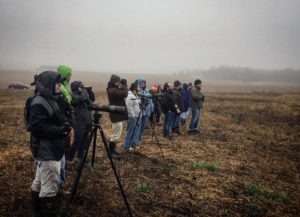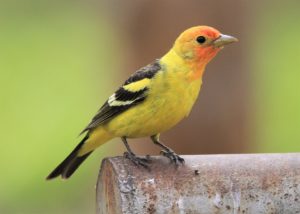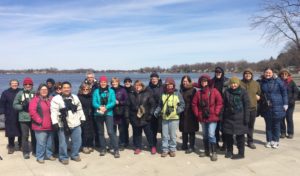A Guide to Recording Birds by Matt Wistrand

A few years back, I was looking for a LeConte’s Sparrow that had been reported at Prairie Green in Kane County. I never did see the bird, but periodically would hear a long, downslurred, tinny call. Could I know this was a LeConte’s Sparrow, and not another species like Savannah Sparrow? As I researched this, I found almost zero information regarding the vocal behavior of our Ammodramus sparrows. So I decided to explore this behavior myself, and purchased a Sennheiser ME66 shotgun microphone and an adapter for my iPhone. Since then recording has become a passion and an obsession, and I strive to record every sound I hear in the field. Of course, you do not actually need to purchase an expensive recording set to do the same. You can still obtain surprisingly good recordings with your phone, especially with the right tools and technique.
When recording bird sounds, you want control over the gain and the quality. The built-in voice recorders on your phone encode audio as MP3 files, which results in a smaller file size but also lower quality. For the iPhone, Audio Memos Pro can be configured to record to WAV files, and gives control over both the sound quality and the gain level. For Android, Cornell has recommended an app like RecForge II, and Nathan Pieplow recommends SpectralPro Analyzer.
Once you have your phone configured to record properly, you may want to add an external microphone if you already have one. The team at the Cornell Lab of Ornithology tested several smaller external microphones, but found they do not make enough of a difference to make them useful. The exception to this is using a shotgun or parabolic microphone, which was quite effective as my initial setup. However, be aware that if you do so, you will likely need to disable voice activation on your phone, which can be difficult to do completely.
Beyond equipment, you can employ a number of techniques to improve the quality of your recordings. Sound quality is largely a function of distance. You can boost the recorded volume of the bird’s song or call by 6dB by halving the distance between the microphone and the bird (a significant improvement). So the first step to ensuring a good recording is getting as close to the bird as you can without disturbing it. Next, try to position your phone’s microphone so that unwanted noise from cars or other birds is minimized. Further, longer recordings are always more valuable than shorter ones, since birds often switch between different songs and calls. As a rule, I try to leave the recorder running until the bird stops vocalizing (unless, of course, the bird is agitated by my presence). Finally, to reduce fatigue, keep your arm down at your side. It may be tempting to extend your arm to get closer to the bird, but the added reach is too small to noticeably affect the recording.
After a recording session you have the option to leave your recording as is, or edit it lightly to reduce interference. Recordists vary in their opinions on editing. Some adamantly oppose all modifications, while others will lightly amplify or filter their recordings as needed. That said, there are not many places in Illinois where you can escape background noise, especially if you live in the northeast portion of the state. Between normal commuter traffic, airline traffic from two major airports, and the fact that more trains pass through Chicago than any other major US city, it is nearly impossible to obtain a recording free from heavy background noise. As such, I dampen the noise in the first kHz of most of my recordings, with the exception being recordings of low-pitched vocalizations like heron grunts. Such filtering is easy with free tools like Raven Lite or Audacity. There are several online guides available to help you use these filters.
With spring migration underway, there will be many opportunities for you to record both songs and calls. It is worth getting into the habit of regularly recording the sounds you hear now. So when that singing MacGillivray’s Warbler shows up at your local forest preserve, you won’t walk away realizing you could have recorded its song but in your excitement completely forgot to do so.
by Matt Wistrand



